
When picking socks for sweaty workouts, I choose Merino wool, synthetic blends, or bamboo, all of which feature breathable sock material. These materials are great because they keep feet dry and comfy.
For example, Merino wool absorbs sweat but pushes water away, helping it dry fast. New technology has made synthetic blends stronger and quicker to dry. Cotton, on the other hand, holds moisture and feels uncomfortable. These breathable sock materials are better at letting air in and stopping bad smells.
Choosing breathable socks can really help you do better during tough workouts.
Key Takeaways
- Pick socks made of Merino wool, bamboo, or synthetic fabrics for better airflow during workouts.
- Look for socks that pull sweat away to keep feet dry and stop blisters.
- Choose socks with mesh parts to let air in and avoid overheating during hard exercises.
- Stay away from cotton socks because they hold sweat and can feel bad or smell.
- Go for synthetic fabrics like polyester to handle sweat better and dry faster.
- Try socks made of both natural and synthetic fibers for comfort, strength, and breathability.
- Look for extras like seamless toes and compression to feel better and perform well.
- Take care of your socks by washing gently and letting them air-dry to keep them working well.
What Does “Breathable” Really Mean in Sock Materials?
When we talk about breathability in socks, we're talking about how well the material allows air to flow and moisture to escape. This is especially crucial for high-sweat workouts like HIIT, running, or circuit training.
Breathability in sock materials refers to the fabric’s ability to promote airflow and wick moisture away from the skin to keep feet dry and cool.
Now that we’ve defined breathability, let’s take a closer look at which materials are actually engineered to do this best.
How Does Moisture Management Work?
When I think of breathable sock material, I think of moisture control. Socks for sweaty workouts use fabrics that wick away sweat. These fabrics pull sweat off the skin and spread it out. This helps the sweat dry faster and keeps feet comfy. It also lowers the chance of blisters caused by wet skin rubbing.
Tests show that materials like polypropylene are great at wicking sweat. They even work better than wool and nylon. Wool blends soak up more sweat, making them good for activities with changing sweat levels. The way fibers are made also matters. Tighter weaves move sweat better, so it doesn’t stay on your skin.
Tip: Pick socks with advanced sweat-wicking features. Some can cut foot sweat by 40%, stopping smells and discomfort during hard workouts.
I always check for mesh panels in socks. These panels let air flow and stop heat from building up. This helps sweat dry faster. Lightweight socks also help manage sweat and keep feet from overheating.
Why Is Air Circulation Important for Your Feet?
Airflow is as important as sweat control when picking breathable socks. Good airflow cools feet and stops heat and sweat from building up. Socks with mesh or light fabrics boost airflow, keeping feet cool during workouts.
Socks with bad airflow trap heat and make feet feel stuffy. This can cause extra sweating and even bacteria growth. Synthetic fabrics like polyester and nylon allow air to flow while staying strong. Cotton breathes but holds sweat, so it’s not great for sweaty activities.
Tests on how fast fabrics dry show why airflow matters. Fabrics that let sweat evaporate quickly keep feet dry and comfy. Mesh panels help in hot spots like the arch and toe area, making socks more breathable.
Note: Socks made with mixed materials balance airflow and sweat control. They mix natural fibers for cooling with synthetics for strength, perfect for tough workouts.
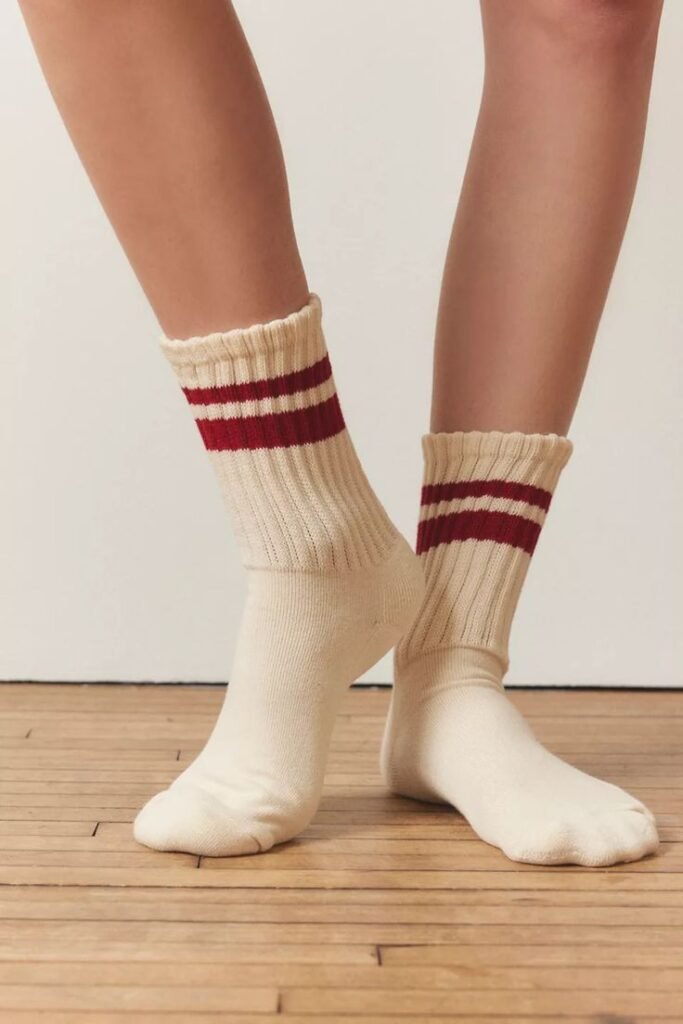
Which Natural Materials Are Most Breathable?
Natural fibers like cotton, bamboo, and merino wool are often marketed as breathable—but are they really ideal for high-intensity workouts?
Among natural fibers, merino wool and bamboo viscose stand out for their balance of moisture control, odor resistance, and comfort.
But natural doesn’t always mean better. Let’s explore the performance of synthetic materials too.
Some natural materials are great for keeping feet cool and dry. Merino wool and bamboo are two of the best choices. They are breathable, manage sweat well, and feel comfy. However, they work differently based on the weather and activity.
Is Cotton Really a Bad Choice for Sweaty Workouts?
Cotton is soft and cheap, but it’s not good for sweaty workouts. It soaks up sweat instead of pulling it away. This makes socks damp, causing blisters and discomfort.
Unlike Merino wool or bamboo, cotton doesn’t control temperature well. It holds sweat, making feet feel hotter during hard exercises. After even a short workout, cotton socks stay wet. This can lead to bad smells and bacteria growth.
Tip: Avoid cotton for sweaty workouts. Pick socks that wick sweat and dry fast.
How Does Bamboo Compare to Merino Wool?
Bamboo and Merino wool are my top natural sock materials. Both are breathable and comfy, but they have different strengths:
- Merino wool has tiny fibers (15-24 microns) that feel soft. These fibers pull sweat away, keeping feet dry during tough workouts.
- Bamboo is very breathable and feels smooth. It’s easier to find and often costs less than Merino wool.
I think Merino wool is better for cold weather. It traps air to keep feet warm and controls temperature well. Bamboo works in all climates. It’s light and breathable, perfect for warm or cool conditions.
Both materials naturally fight odors, which is great for sweaty workouts. For cold weather, I’d pick Merino wool for warmth. For all-year use, bamboo is a great option.
Note: Choose between bamboo and Merino wool based on the weather and activity. Both are excellent breathable sock materials, but their benefits depend on your needs.
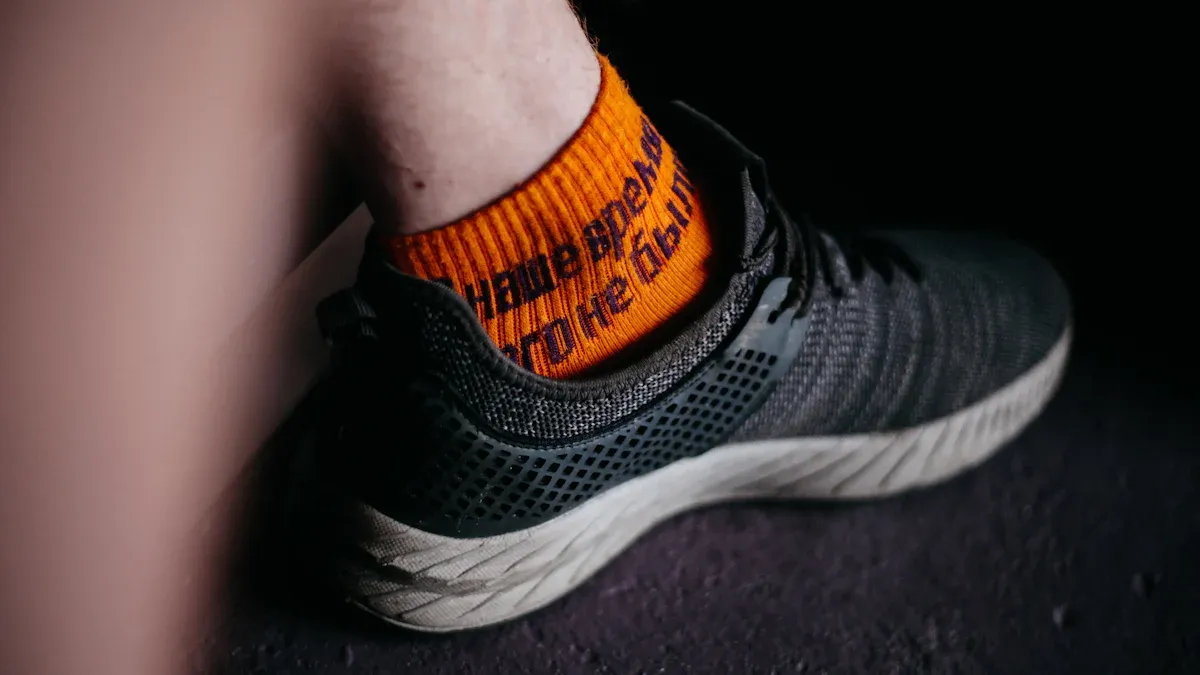
Are Synthetic Materials Better for Sweat Control?
Synthetic materials like polyester, nylon, and spandex are commonly used in performance socks for their moisture-wicking and durability features.
Polyester blends and nylon-based fabrics are generally more effective than natural fibers at wicking sweat and maintaining structure during high-intensity training.
Still, not all synthetics are created equal. Let’s examine how they perform side by side with natural options.
How Are Nylon and Polyester Different in Socks?
Nylon and polyester are common synthetic fibers in socks. Both are strong and light, but they handle sweat differently. Nylon doesn’t wick sweat away very well. Polyester is much better at pulling sweat off the skin. It also dries faster than many other fabrics.
Here’s a simple comparison:
| Material | Sweat-Wicking Ability | Drying Speed |
|---|---|---|
| Nylon | Low | N/A |
| Polyester | 15% faster drying | Beats acrylic |
From what I’ve seen, polyester socks are best for sweaty workouts. They keep feet drier than nylon. Nylon, though, adds strength and stretch to sock blends. This makes socks fit well and last longer.
Tip: Choose socks with both polyester and nylon. This mix gives good sweat control and durability, making socks breathable and tough.
How Do Synthetic Fabrics Fight Odor and Bacteria?
Sweaty workouts can cause smelly socks. Synthetic fabrics like polyester and nylon don’t naturally stop odors. But new technology has fixed this problem. Many synthetic socks now have treatments to block bacteria growth. This helps reduce bad smells after tough workouts.
Socks with silver or copper fibers work really well. These metals kill bacteria and stop them from growing in damp socks. Polyester treated with these features is great for fighting odor.
Untreated synthetic socks can hold smells if not cleaned well. I suggest picking socks with odor-fighting features. This keeps your feet fresh, even during sweaty exercises.
Note: Synthetic socks work best with smart designs like mesh panels. These features improve airflow and comfort, making them great for workouts.
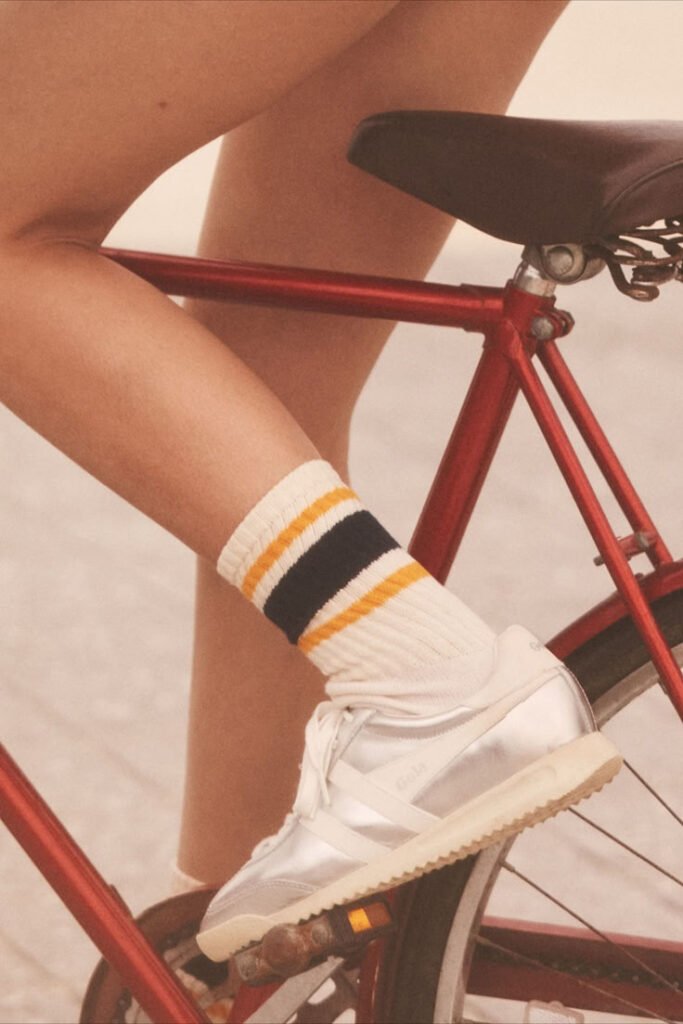
How Do Fabric Blends Improve Breathability?
Many of the best socks don’t rely on a single material—they’re engineered blends combining the best properties of both worlds.
Blends like merino wool with nylon or polyester with spandex offer enhanced breathability, elasticity, and durability for sweat-heavy training sessions.
Next, we’ll look at the top material combinations to watch for when shopping for performance socks.
Why Are Wool-Nylon Blends So Popular?
Wool-nylon blends are loved by athletes and hikers. These blends mix wool’s sweat-wicking and temperature control with nylon’s strength. Merino wool pulls sweat away, keeping feet dry and comfy. But wool alone wears out fast. Nylon makes the socks stronger and keeps their shape after many uses.
These blends are also great for all weather. Wool fights sweat and smells, while nylon keeps socks light and airy. This mix works well for sweaty activities like running or hiking. Many top athletic socks use this blend for its performance.
Tip: Choose socks with 20-30% nylon. This mix gives comfort, breathability, and durability.
What’s the Ideal Ratio of Stretch and Structure?
Socks need the right mix of stretch and support. Too much stretch makes them loose, while too much structure feels stiff. Materials like spandex or elastane add just enough stretch. They help socks fit your feet without feeling tight.
Nylon and polyester add strength and keep socks in shape. A good blend is 2-5% spandex or elastane with 20-40% nylon or polyester. This mix allows movement while keeping socks snug and supportive.
Note: Socks with reinforced heels and toes last longer. These areas stay strong without losing breathability, perfect for tough workouts.
Blended fabrics make socks last longer and feel better. By mixing natural and synthetic fibers, socks manage sweat, airflow, and fit well. This makes them a great choice for sweaty activities.
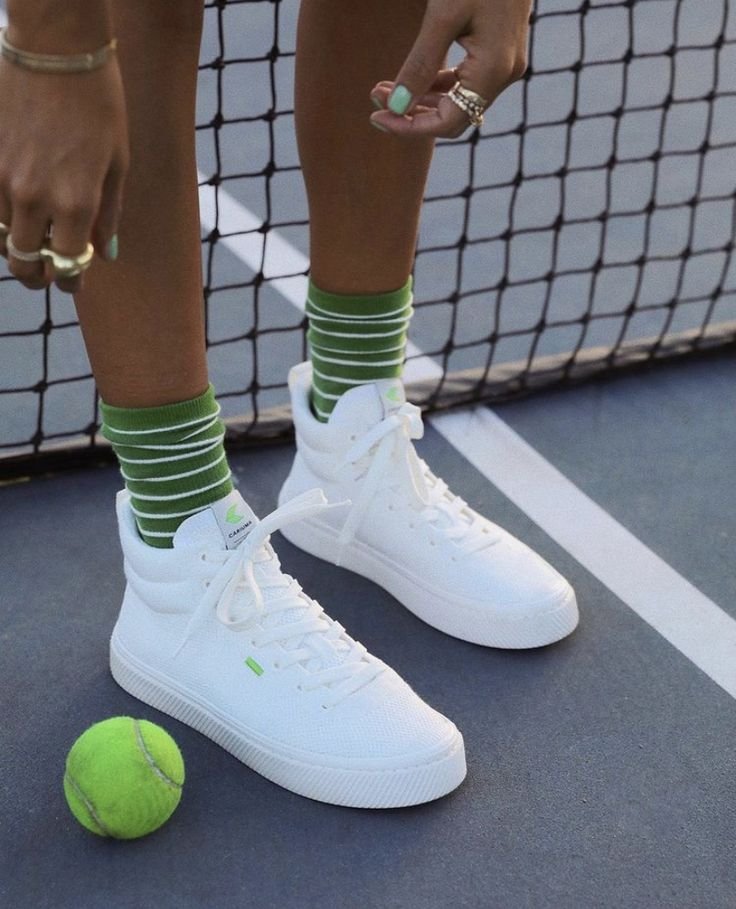
Which Sock Materials Work Best for Different Workouts?
Your training style also matters. What works for runners may not suit a HIIT enthusiast or heavy lifter.
HIIT training benefits from lightweight synthetics, running needs blister-resistant blends, and gym workouts require odor-resistant, durable materials.
Let’s pull it all together and help you make the smartest choice based on your workout routine.
What’s Good for Long-Distance Runners?
Running long distances makes feet sweat and rub a lot. Socks need to handle this. Merino wool and synthetic blends are great choices. Merino wool pulls sweat away and stops bad smells. It keeps feet dry and fresh during long runs. It’s also soft and doesn’t itch, which is good for sensitive skin.
Synthetic fibers like polyester and nylon make socks stronger. They also help manage sweat better. Socks like Smartwool Run Ankle Socks and Darn Tough Micro Crew Ultra-Lightweight Running Sock mix wool with synthetics. This mix gives comfort and strength.
Special fibers like olefin and Tencel improve airflow and sweat control. They keep feet dry and stop blisters by reducing rubbing. Avoid cotton socks. Cotton holds sweat, making feet wet and uncomfortable.
Tip: Pick socks with strong heels and toes. These parts protect feet during long runs and last longer.
What Works for CrossFit and HIIT?
CrossFit and HIIT workouts are fast and intense. Socks for these need to handle lots of sweat and stay in place. Synthetic blends are the best choice. Polyester mixed with spandex or elastane fits snugly and dries quickly.
Breathable socks are important for these workouts. Mesh panels let air in, keeping feet cool during hard exercises. Nylon adds stretch and strength, so socks last longer.
Stopping bad smells is also key. Many synthetic socks now have special treatments, like silver or copper fibers. These stop bacteria from growing, keeping socks fresh after tough workouts.
Note: Look for socks with compression arches. This feature supports feet and helps reduce tiredness during quick movements.
When picking socks for sweaty workouts, I look for materials like Merino wool, bamboo, and synthetic blends. These materials are great at keeping feet cool and dry. Synthetic blends, like polyester mixed with nylon and spandex, dry faster and last longer than natural fibers during tough exercises.
Special sock designs also make workouts more comfortable and effective. Features like seamless toes, airflow panels, and compression support improve how socks work. Here’s what these features do:
| Feature | What It Does | Why It Helps |
|---|---|---|
| Seamless Toe Design | Stops rubbing and makes socks more comfy | Smooth design prevents rubbing on toes, lowering the chance of irritation. |
| Airflow Panels | Let air in to cool your feet | Built-in panels allow air to flow, keeping feet cool even in hard workouts. |
| Compression Support | Helps feet feel less tired and boosts endurance | Supports arches to reduce tiredness and improve comfort during exercise. |
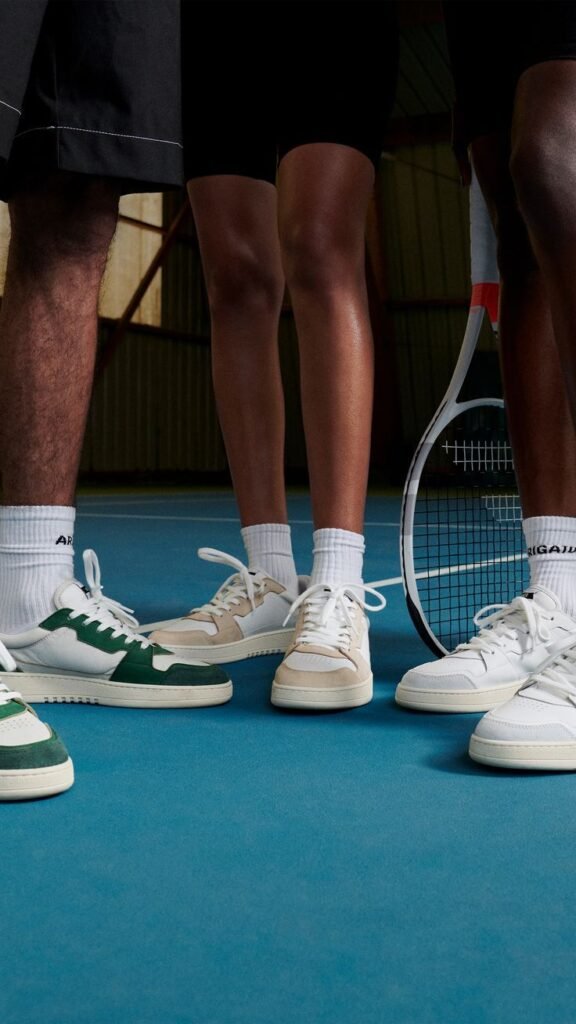
Conclusion
By using breathable materials and these smart features, my feet stay dry, comfy, and supported during every workout.
FAQ
1. What makes a sock material "breathable"?
Breathable materials let air move through and pull sweat away. This keeps your feet cool, dry, and comfy during exercise. Materials like Merino wool, bamboo, and polyester are great at stopping sweat and heat buildup.
2. Why is cotton not ideal for sweaty workouts?
Cotton holds sweat instead of pulling it off your skin. This makes socks wet and uncomfortable, causing blisters and bad smells. For sweaty activities, pick fabrics like synthetic blends or Merino wool that wick sweat away.
3. Are synthetic socks better than natural ones?
Synthetic socks often handle sweat and last longer than natural ones. Polyester dries fast and pulls sweat off the skin, while nylon adds strength. Natural options like Merino wool and bamboo breathe well and fight odors, making them good for certain needs.
4. How do I choose socks for different workouts?
For running, use Merino wool or synthetic blends to stay dry and comfy. For CrossFit or HIIT, synthetic socks with mesh and compression work best. Always match your socks to the type and intensity of your workout.
5. What features should I look for in breathable socks?
Find socks with mesh zones for airflow, seamless toes to stop rubbing, and compression arches for support. Materials like polyester, nylon, or Merino wool combined with these features make workouts more comfortable.
6. Do breathable socks help prevent blisters?
Yes, breathable socks pull sweat away and lower friction, reducing blisters. Merino wool and polyester blends are especially good at keeping feet dry and comfy during hard workouts.
7. How do I care for breathable socks?
Wash socks in cold water with gentle soap to keep them working well. Skip fabric softeners, as they can hurt sweat-wicking ability. Let socks air-dry to keep their shape and stretch.
8. Can breathable socks reduce foot odor?
Yes, many breathable socks fight odors. Merino wool and bamboo naturally stop bacteria, while synthetic socks often have treatments to block smells. These features keep feet fresh during sweaty workouts.
Tip: Use different pairs of breathable socks to make them last longer and stay fresh.
Related
1.Different Types of Quick-Drying Fabrics and How They Are Tested →
2.Moisture Management →
3.What Makes a Sock “Breathable”? We Break It Down →
4.Merino wool vs cotton and other fabrics →
5.6 Reasons Bamboo’s Better than Merino →
